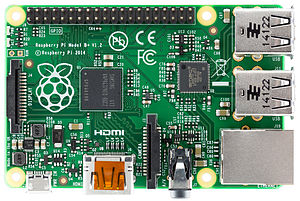I give the new Raspberry Pi B+ an A-


I know that a lot of you read my, "Raspberry Pi: How I spent almost $150 on a $35 computer" piece and came away angry about it. I'm still not sure why that happened, but I received a lot of hate mail proclaiming my ignorance, my stupidity, and my downright disregard for all that is cool about the Raspberry Pi (RPi) board. Whew! It was a rough ride, but I'm over it now and ready to look again at the RPi's newest incarnation: The B+. It's a big improvement over the prior models and before you get all huffy on me, I give the B+ an A-.
My two favorite B+ features are four USB ports (compared to two on the B board) and the micro SD card slot (compared to the full-sized SD card slot on the B board). Micro SD is the perfect platform for a board this small. That, and the micro SD card doesn't stick out too far from the board's boundaries.
My least favorite B+ feature is the wired Ethernet port. Seriously, stop putting that on there. You don't need it. Use a wireless one instead. No one wants to connect a wired Ethernet to a small board like this.
In fact, the B+ is a very well done redesign. The component interfaces are much more in line with the physical limits of the board. The B had interfaces sticking out far beyond the board surface, which made it hard to fit into some compact boxes and cases, unless the boxes or cases were specifically designed for the B. This one is much more compact even though the board size is the same.
The RPi B+ is much more what I had in mind when I bought my B version.
The B+ still sports the standard 700MHz Broadcomm BCM2835 CPU and still has 512MB RAM, which is enough for a lot of general computing applications. I'm more than a little shocked at the Raspberry Pi folks because they didn't bother upgrading the CPU or the RAM in the B+. They've done such a brilliant job on the other parts that it's a bit disappointing that they didn't pump up the volume on this round.
Everything on the B+ board is more organized and better placed, although the camera serial interface (CSI) and display serial interface (DSI) didn't move very much. But the DSI is now situated very close to the edge of the board making it more convenient for cabling.
In my opinion, the B+ RPi board is top notch technology and craftsmanship. I love the new styling, the rearrangement of ports, and the expanded GPIO (from 26 pins to 40 pins). And a feature that would only matter to a geek: There are four mounting holes instead of just two. Four mounting holes provides more flexibility and more stability for cases and other pluggable peripherals. For example, the B board's GPIO had no mounting hole near it and I always felt like I had to be extra careful not to damage the pins when plugging and unplugging. Having mounting holes on both sides of the GPIO gives it the sturdiness needed for such a small board.
Raspberry Pi : Vital statistics
The new board also features lower power consumption by replacing linear regulators with switching ones they’ve reduced power consumption by between 0.5W and 1W. I didn't notice the B board using a lot of power, but now my rechargeable battery packs will last a lot longer and that's always a good thing.
While this post is not a review, I'd give this new RPi board a very strong A- for a grade. Hopefully in the 'C' board, or whatever they decide to call it, will feature a wireless Ethernet and perhaps 1GB RAM. Those two changes would earn the RPi an A+ from me.
The Raspberry Pi B+ board is especially exciting for those who want to create and market their own branded "things" for the Internet of Things applications. I'd love to hear about your projects with the RPi B+ and to see what you've done with it. The more unusual and creative, the more likely I'd be to feature it in a future post.
Special thanks to element 14 for sending me the B+ for a look.
Related Stories: